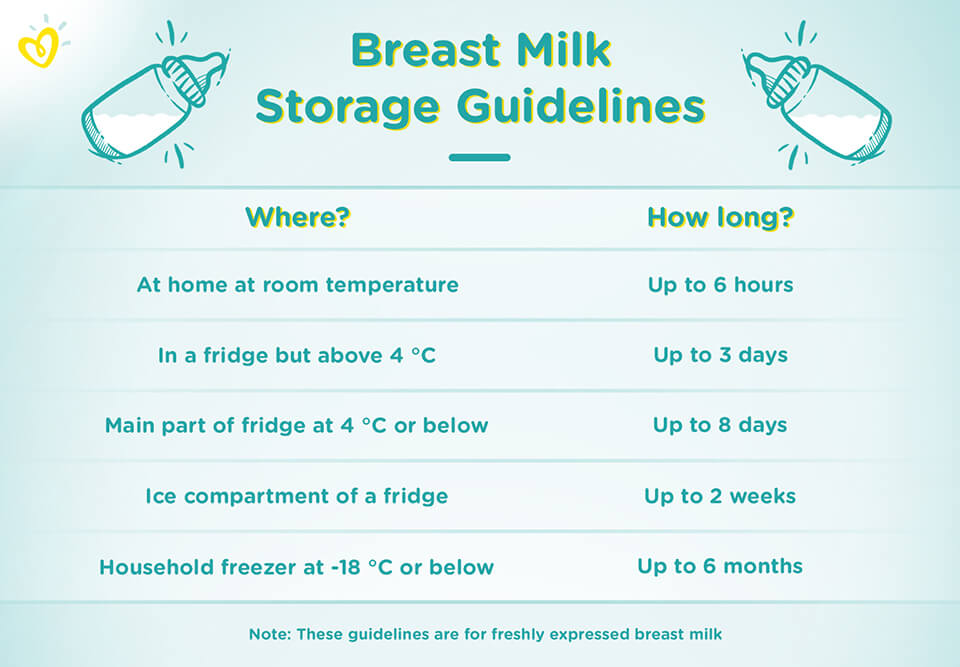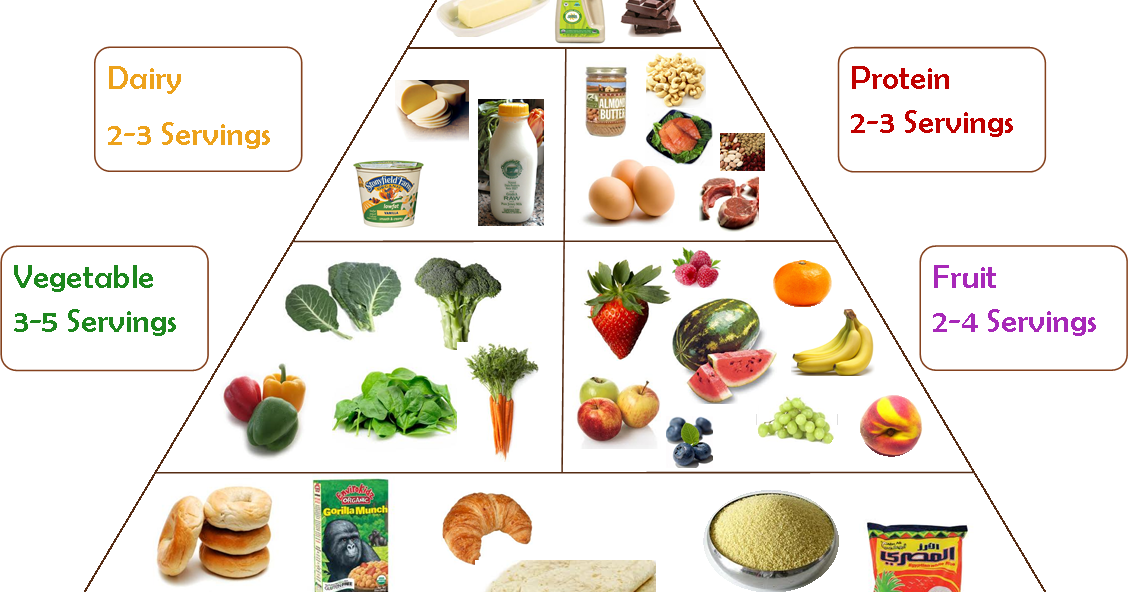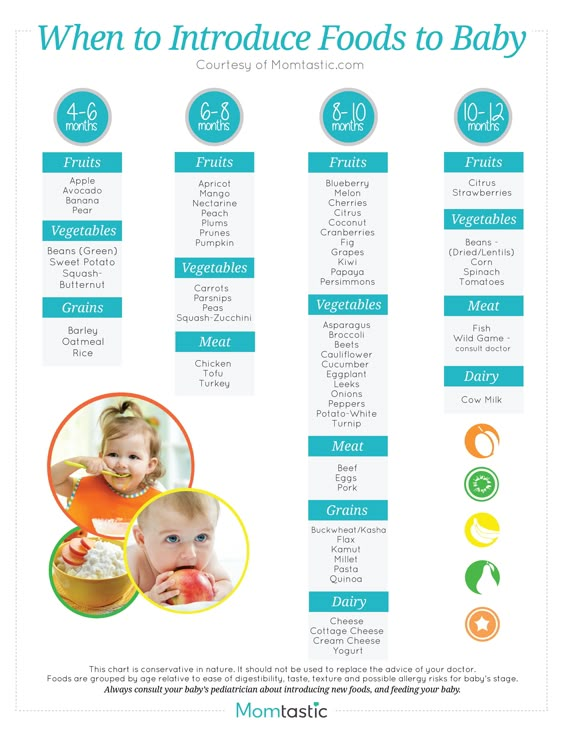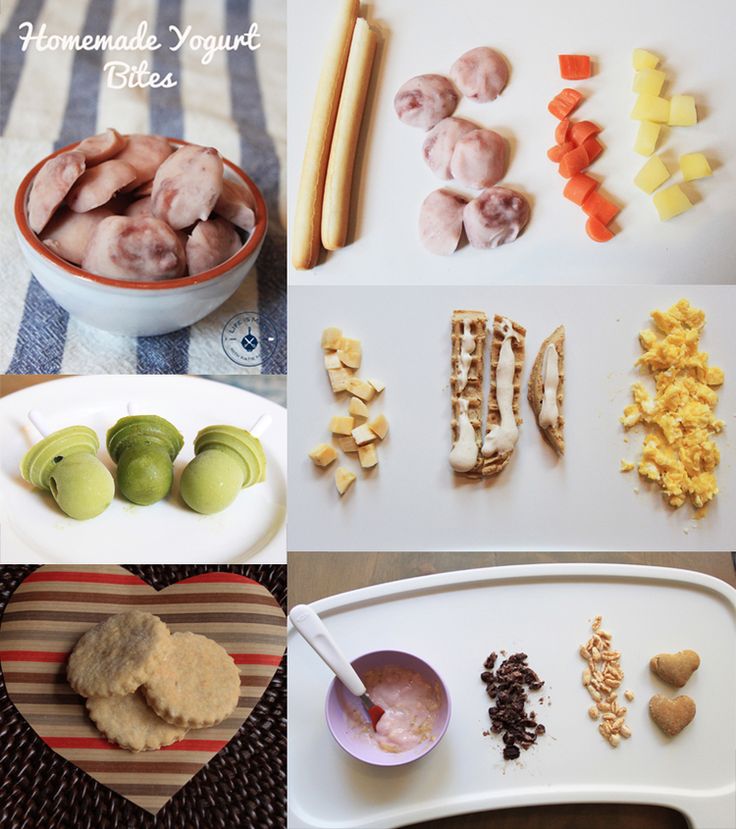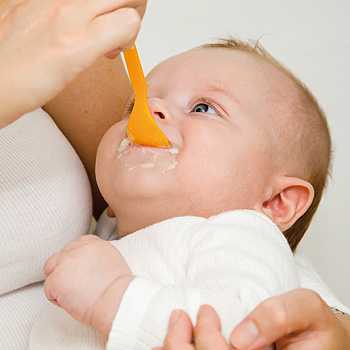What kind of squash for baby food
Squash Baby Food Recipes, Make Homemade Squash for Baby Food, Introducing Squash to Baby
While the recommended age for starting solid foods is generally 6 months of age, many babies start solids between 4 and 6 months of age. These recipes are appropriate for this age range.
Winter Squash, like butternut squash and acorn squash, is a wonderful first food for your baby. High in Vitamins and Calcium – smooth, delicious and very nutritious, these winter squashes are sure to be a hit with your baby.
Just check out the amount of Vitamin A and Folate 1 cup of baked squash cubes contain: Folate – 57.40 mcg and Vitamin A – 7,291.85 mg.
When can I introduce Butternut Squash or Acorn Squash to my baby?
Squash may be offered as early as 4 – 6 months old. Butternut and acorn squash are wonderful additions to baby’s first foods. These winter veggies roast up to tasty flavorful perfection and blend and puree into as thin of a texture as you require.
The goodness of Butternut Squash, Acorn Squash, and other Winter Squash for baby food
Winter Squash
As the nutritional content of Winter squash varies with the variety of squash, you will find a nutritional summary accounting for all varieties below:
Nutrition Facts (1 cup cooked-baked, butternut cubes)
Univ. of IL – Watch Your Garden
Calories – 79.95
Protein – 1.82 grams
Carbohydrate – 17.94 grams
Dietary Fiber – 5.74 grams
Calcium – 28.7 mg
Iron – 0.67 mg
Potassium – 895.85 mg
Folate – 57.40 mcg
Vitamin A – 1144 IU
How to select and store Butternut Squash, Acorn Squash and other Winter Squash for baby food
According to the EWG, winter squash such as butternut and acorn are not one of the “dirty dozen” foods that are most highly contaminated with pesticides. Hard rind or shelled fruits and veggies usually keep out any contaminants. Purchasing organic is a personal choice.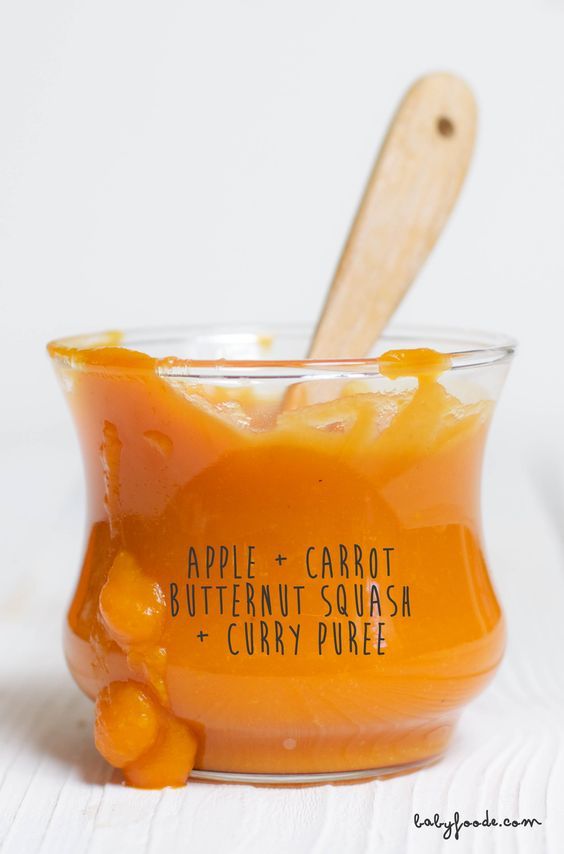
A squash is characterized as a “Winter” squash not only due to the season in which it grows, but also due to the way the squash itself grows. Winter squash actually mature on the vine and do not further mature or ripen once harvested. The rind or shell of a Winter squash is very hard and thick. Peak season for Winter squash is November through December.
Acorn and the Butternut are the best choices for baby’s first squash experience. Additional varieties of winter squash can be found below. These types of squash are best given to an infant between 6-8 months old. (If you start solids early at 4 months, winter squash is also appropriate.)
images: GettyButternut Squash: Butternut squash is light tan in color, and is bell-shaped or shaped like an elongated pear. Butternut squash has a deep orange flesh, and is loaded with a sweet, nutty flavor.
Acorn Squash: This squash is probably one of the most easily recognized and most often eaten.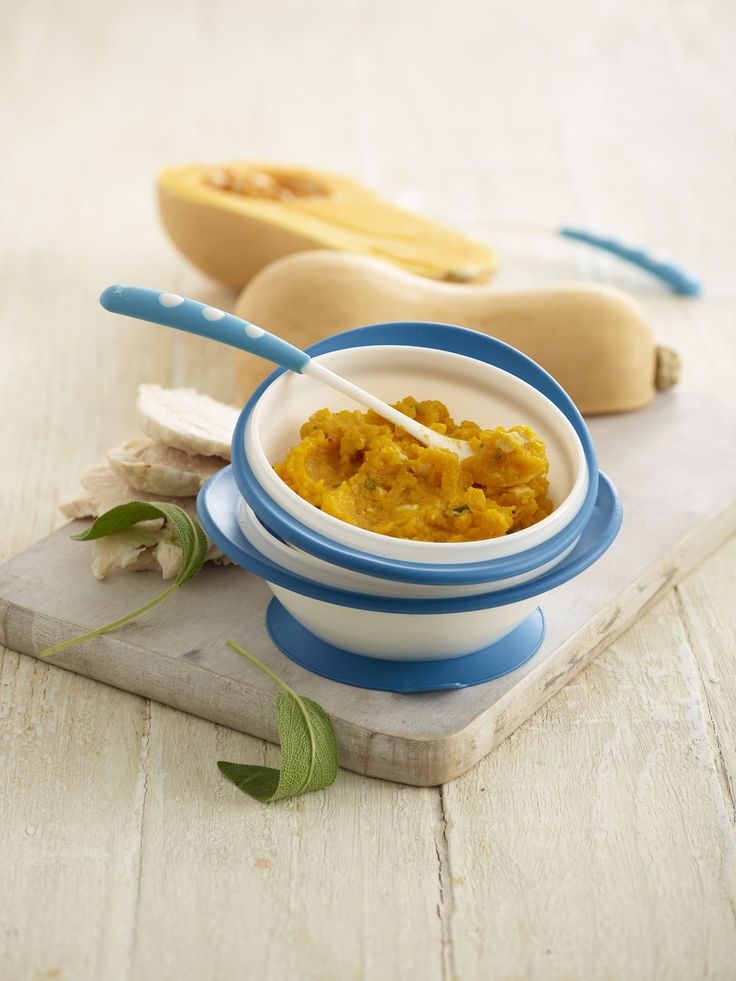 It does have an acorn shape to it, along with deep furrows. The acorn squash is typically a deep dark green, however there are some varsities that are yellow or orange. Regardless of the color of the acorn squash, the meat is sweet and yummy baked with brown sugar and a dash of cinnamon.
It does have an acorn shape to it, along with deep furrows. The acorn squash is typically a deep dark green, however there are some varsities that are yellow or orange. Regardless of the color of the acorn squash, the meat is sweet and yummy baked with brown sugar and a dash of cinnamon.
Hubbard Squash: You can’t miss a Hubbard. This squash is typically very large and looks like a misshapen teardrop. Bumpy and thick-skinned, it has a blue-gray or sometimes a sea green color. The flesh is rich and slightly sweeter than a banana squash.
Delicata Squash: You may know this squash as sweet potato or bohemian squash. It is a bit like an acorn squash in shape though more cylindrical, like a butternut. The shell of a Delicata is rather pretty; it is yellow with green stripes and reddish-brown spotting or spattering. The meat is a pale yellowish-orange and the taste is mild and a bit like corn.
The best way to store butternut squash, acorn squash or other winter squash for baby food
Winter squash typically may be stored for a long period of time.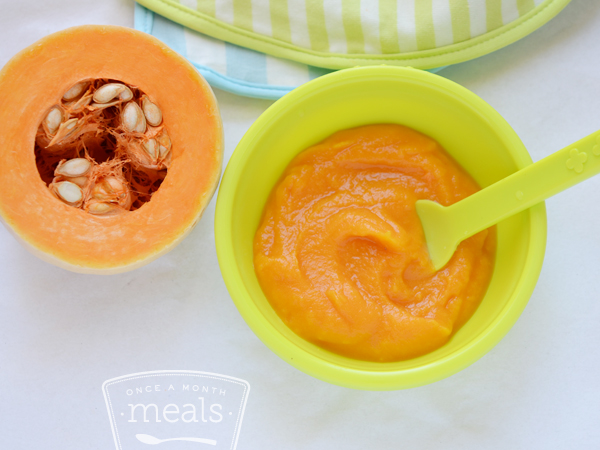 Depending on the variety, a winter squash such as the Butternut, may be stored for up to four months. Store your winter squash in a cool dry place for optimal storage times.
Depending on the variety, a winter squash such as the Butternut, may be stored for up to four months. Store your winter squash in a cool dry place for optimal storage times.
The best way to cook butternut squash, acorn squash and other winter squash for baby food
The best way to cook butternut squash, acorn squash and other winter squash for baby food recipes is to bake or roast the squash. You retain the most nutrients while bringing out the most flavor. Roasting or baking winter squash is also easier because you won’t spend forever and a day tying to peel and cube the squash for steaming or boiling.
How to bake or roast a butternut squash for baby food
Step 1: With a sharp kitchen knife, cut the butternut squash in half – lengthwise.
Kristi wrote to us to share this little tip for cutting hard winter squashes:
“I recently read about a great tip to help cut butternut squash (I haven’t tried acorn but also works well with small pumpkins).
Place whole squash in the microwave and cook on high for about 2 minutes. This makes the initial cutting of the squash really easy.”
Step 2: Scoop out the seeds from the round end of the cut butternut squash
Step 3: Lay butternut squash “face” or meat-side down in a baking dish with about 1-2 inched of water.
Step 4: Bake at 400 degrees F for 40 minutes or until shell/skin looks puckery and turns a darker tan.
From here, you’re ready to make a variety of purees, below.
Enjoy these butternut squash baby food recipes, acorn squash and other winter squash baby food recipes
Butternut or Acorn Squash – Basic Purée (4)6 months+Ingredients:
- 1 acorn or butternut squash
- Follow directions as to how to bake or roast a butternut squash for baby food above.
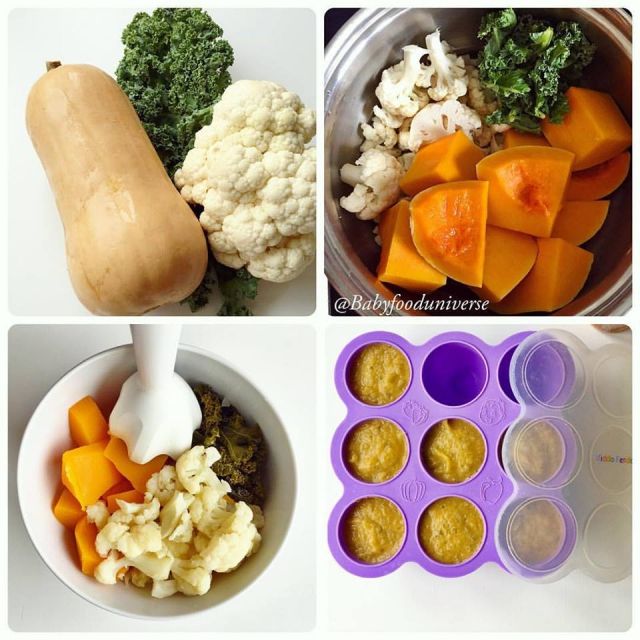
Step 1: Place squash “meat” into your choice of appliance for pureeing and begin pureeing.
Step 2: Add water as necessary to achieve a smooth, thin consistency.
You can also peel the squash, scoop out the seeds and then cut into chunks and boil/steam until tender (like when boiling potatoes for mashed potatoes) then follow steps 4 and 5 – this way is most difficult however and rather time consuming.
Photos: Chelsea Foy
Rice with Apple and Butternut Squash Purée – (4)6 months+
Ingredients:
- 1 squash – acorn, butternut or other winter squash
- 1 or 2 cups cooked brown rice
- 1/2 cup applesauce
Directions:
Step 1: Cut acorn or butternut squash in half, scoop out seeds
Step 2: Place halves face down in a pan and cover with an inch of water
Step 3: Bake in a 400 degree oven for 40 minutes or until the “shell/skin” puckers and halves feel soft then scoop squash “meat” out of the shell
Step 4: Place squash “meat” into your choice of appliance for pureeing
Step 5: Add cooked rice and applesauce and blend
Step 6: Add water as necessary to achieve a smooth, thin consistency
Baby’s Acorn Squash & Apple Bake – 6-8 months+
Ingredients:
- 1 acorn squash
- 2 or 3 Macintosh apples
- pinch of cinnamon
Directions:
Step 1: Peel and dice apples
Step 2: Cut acorn or butternut squash in half, scoop out seeds
Step 3: Place halves face UP in a pan and add with an inch of water to the pan
Step 4: Place diced apples in the squash “holes” where the seeds were
Step 5: Sprinkle with cinnamon if desired
Step 6: Pour water over the apples so that there is water in the squash holes – cover pan with tinfoil
Step 7: Bake in a 400 degree oven for 40 minutes or until the “shell/skin” puckers and halves feel soft then scoop squash “meat” and apples out of the shell
Step 8: Puree as needed, adding water to thin if required. You may also chop or dice and serve as a finger food meal.
You may also chop or dice and serve as a finger food meal.
This baked medley is very nice when mixed with brown rice or quinoa.
Squash & Rice “Soup” 6 months+
Ingredients:
- 1 cup cooked mashed butternut squash (works well with pumpkin too.)
- 1/2 cup water
- 1/4 cup cooked brown rice
- dollop whole milk yogurt (optional for 8 months+)
Directions:
Step 1: Mash squash with the water in a food processor or blender and slowly mix in the brown rice.
Step 2: Process to a consistency that your baby enjoys and can handle then stir in the yogurt
Butternut Squash Baby Food Recipes – Baked Acorn Squash Bowls
This is a great way to get baby interested in self-feeding; plop down the whole squash bowl and let him chow down (under strict supervision of course and ensuring that he is ready to dive in like this!)
Ingredients:
- 1 acorn or butternut squash
- 2 tablespoons applesauce
- handful of raisins
- cinnamon (as you prefer)
- ginger (as you prefer)
- nutmeg (as you prefer)
Directions:
Step 1: Cut acorn or butternut squash in half, scoop out seeds
Step 2: Wipe insides with butter or olive oil and add raisins and applesauce
Step 3: Add 2 inches of water to a baking pan
Step 4: Place halves face up with shell down in a pan
Step 5: Bake in a 400 degree oven for 40 minutes or until the “shell/skin” puckers and halves feel soft.
Step 6: Serve as is in the shell to older toddlers (our kids LOVE this in the shell.) or scoop out the meat and mash then serve.
Back to Top
Savory Butternut Squash & Potato Puree (or Mash) 6 months+
Ingredients:
- 1 2-3 lb. butternut or acorn squash – you may use any winter squash for this dish.
- 1 lb. potatoes, peeled and quartered
- 1 cup heavy cream or half and half – 1 cup whole milk yogurt will work as well <optional for 8 months+>
- 2 tbsp. butter or olive oil
- 1/4 c. finely chopped fresh chives
- salt and fresh ground black pepper to taste (omit salt for babies.)
Directions:
Step 1: Cut the squash in half and scoop out the seeds.
Step 2: Peel the shell and cut the squash into 3-inch dices.
Step 3: Place squash and potatoes in a large saucepan and fill with water and 1/2 tsp. salt. Bring to a boil and cook until both the squash and potatoes are fork-tender (30-40 minutes).
salt. Bring to a boil and cook until both the squash and potatoes are fork-tender (30-40 minutes).
Step 4: Drain liquid (reserving about 1 cup) and add in cream or yogurt and butter.
Step 5: Using a potato masher, mash well or puree if desired for your baby’s texture preferences; adding cooking liquid if you want it a bit thinner consistency.
Step 6: Add chives and season to taste with salt and pepper.
Squash Soup** 8 months+ (due to spices)
Ingredients:
- 1 1/2 lb winter squash chopped or 2-12oz pkgs frozen (thawed)
- 1 small onion *
- 1 teaspoon curry powder*
- 1/4 teaspoon ground turmeric*
- 1/8 teaspoon ground pepper *
- 2 cups chicken broth (use no sodium/low-fat or Make Your Own Stock and Broth)
- 1/4 cup sour cream *
Directions:
Step 1: Saute Onions then combine squash, onion and spices.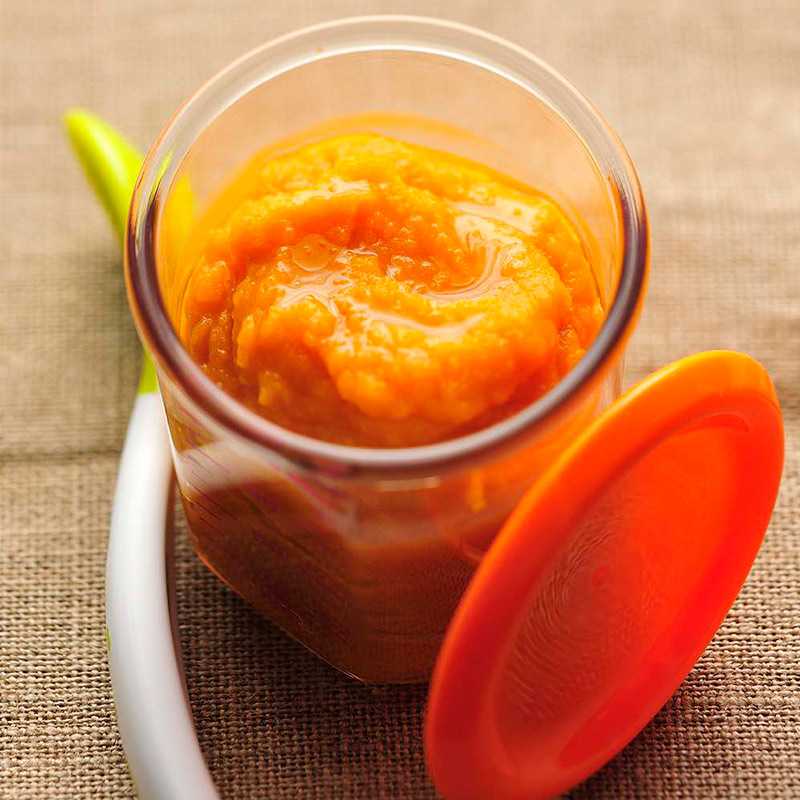 . cook on low for 10 minutes.. stir in broth and cook another 15 minutes.
. cook on low for 10 minutes.. stir in broth and cook another 15 minutes.
Step 2: Cool Slightly and pour 1/3 into blender and blend until smooth, repeating until all of the mixture is blended .. reheat soup before serving and swirl in some sour cream. 4 thumbs up from my twins.
** Please note that you may leave out the * items as needed for your baby’s age and preferences. I like to keep the onion, replace the spices with cinnamon, nutmeg and ginger and also use plain yogurt instead of sour cream.**
Baby’s Stuffed Acorn Squash – MEATLESS 8 months +
Ingredients:
- 2 acorn squash
- 1 tsp canola oil
- 1 medium tart apple, peeled, cored and diced
- 1/2 small onion, finely chopped
- 1/2 cup chopped mushrooms (we leave out the mushrooms.)
- 1/2 celery stalk, diced
- 1/2 tsp dried thyme
- 1/2 tsp oregano
- 1/2 tsp dried sage
- 2 cups cooked whole-grain rice (orzo or couscous are nice as well.
 )
) - 1/2 cup dried apricots, chopped
- 1/4 cup raisins or dried cranberries
- 1/4 cup apple cider (or juice)
Directions:
Step 1: Cut each squash lengthwise in half and scoop out seeds.
Step 2: Place squash halves, cut side down, in baking dish with 1-2 inches of water. Bake for 45 minutes or until shell/skin puckers and squash is soft. Let cool.
Step 3: In a medium skillet, sauté apples, onion, mushrooms, celery for 2-3 minutes. Sprinkle thyme, oregano and sage. Stir in cooked rice, apricots and raisins. Add apple cider, cook until apple cider is almost evaporated.
Step 4: Place cooled squash on a large nonstick cookie sheet. Spoon stuffing into squash cavities. Bake for additional 20 minutes.
Step 5: Serve blended and chopped by scooping out the squash & stuffing from the shell and transferring to a blender or food processor.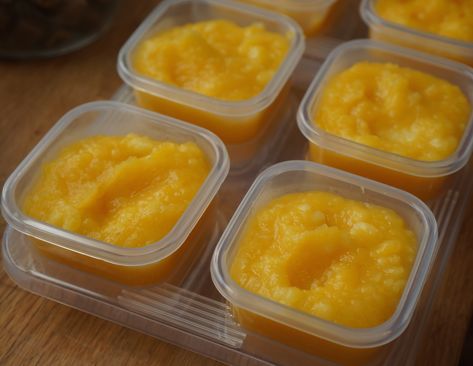 To serve “in the bowl” for older toddlers, gently scrape the squash form the shell so that it falls into the middle with the stuffing and then mash a bit with a fork. Adults may be served as is.
To serve “in the bowl” for older toddlers, gently scrape the squash form the shell so that it falls into the middle with the stuffing and then mash a bit with a fork. Adults may be served as is.
Foods good to mix with Butternut or Acorn Squash:
- Apples
- Peaches
- Pears
- Carrots
- Parsnip
- Brown Rice
- Lentils
- Chicken
- Beef
- Pork
Resources & Learning More:
- Watch Your Garden Grow – Univ. of IL Extension
- Tony Tantillo – Vegetables
- ABQ Journal – Winter Squash
- VegWeb Squash Recipes
Visit the Quick Start to Homemade Baby Food page
Remember, always consult with your pediatrician regarding introducing solid foods to your baby and specifically discuss any foods that may pose allergy risks for your baby.
Butternut Squash Baby Food (Stage One)
This homemade Roasted Butternut Squash Baby Food Puree recipe not only contains calcium, folate, fiber, and vitamins A and C, but it is also a deliciously smooth way to introduce butternut squash to your baby! It’s a great Stage 1 baby food for 4-6 months and up!
Medically reviewed Jamie Johnson, Registered Dietitian Nutritionist (RDN), and Lauren Braaten, Pediatric Occupational Therapist (OT).
This butternut squash puree is a quick and simple recipe that involves roughly 5 minutes of hands-on time! 🖐
We’ll let the oven do all the hard work for the rest of the prep time. Cuz why should we work harder 💪 when we can work smarter? 🙋♀️
Butternut squash contains calcium, folate, fiber, and vitamins A and C and is considered one of the very best first foods for your baby.
Is it your first time making homemade baby food? Then I suggest you start this journey by reading my in-depth Guide on How to Make Homemade Baby Food. The detailed guide goes over all the important information such as the best cooking tools to have on hand, safe storage, how to know when baby is ready for solids, how to introduce purees, the best first foods for baby, and more! You can also check out my best-selling cookbook for even more information and recipes!
Butternut Squash Video
Watch this video to see just how easy it is to make this delicious puree for your baby!
Reasons to Love this Butternut Squash Puree- creamy and smooth
- great for 4-6+ months
- stage one baby food
- healthy — full of essential nutrients for your baby
- easy to make — requires only 5 minutes of hands-on time
- babies will love the sweet and earthy taste
- homemade
- freezer-friendly
- budget-friendly
Health Benefits of Butternut Squash
- High levels of antioxidants and vitamins A and C, which boosts the immune system and reduces inflammation
- A good source of potassium that helps keep bones healthy
- Contains a protein that may be a potent anticancer agent
- Provides calcium to help strengthen bones and folate to help with brain development
Make sure to read the recipe card below for full ingredients and instructions!
- Butternut Squash: This is an easy-to-find, inexpensive, and nutritious food for your baby! When selecting butternut squash, look for a firm squash that has a solid beige color skin without bruising or damage marks.
 The insides will range from bright yellow to burnt orange, so don’t be alarmed if yours is somewhere in that color range.
The insides will range from bright yellow to burnt orange, so don’t be alarmed if yours is somewhere in that color range. - Thyme or Rosemary: We are kicking up the flavor profile with a fun and fresh herb — thyme or rosemary. Either of these herbs will tone down the earthiness of the squash and ramp up its freshness and citrus aspect. You can’t go wrong with either. But you can always skip adding herbs and spices to your baby food if you prefer (see more below).
Adding Healthy Fats Tip: If you are looking to add some extra healthy fat to your baby’s meals, then you can drizzle the butternut squash with extra virgin olive oil before roasting. Olive oil is a healthy fat that is full of omega 3 and omega 6 that helps baby absorb vitamin D which is important for bone growth and strengthening.
Tools NeededThese tools will make it a lot easier for you to make this healthy Sweet Potato puree. For more of my favorite kitchen tools make sure to check out my online shop.
- Baking Sheet
- Blender or Food Processor
- Knives
- Freezer Tray
- Storage Containers for Fridge
- Stasher Bag
- Bib with catch pocket
- Reusable pouches
- Heat Oven: Preheat the oven and line a baking sheet.
- Prep Squash: Cut the butternut squash in half and scoop out the seeds. Place them on the baking sheet with the flesh side down, and brush with olive oil (optional).
- Bake: Place the baking sheet in the oven and bake until easily pricked with a fork.
- Scrape: Let it cool, and then scrape off the skin until you only have the butternut squash left. Add to the blender or food processor.
- Add Herbs: Add in a pinch of thyme or rosemary to the butternut squash.
- Puree: Turn on the blender and puree until smooth, adding liquids if needed.
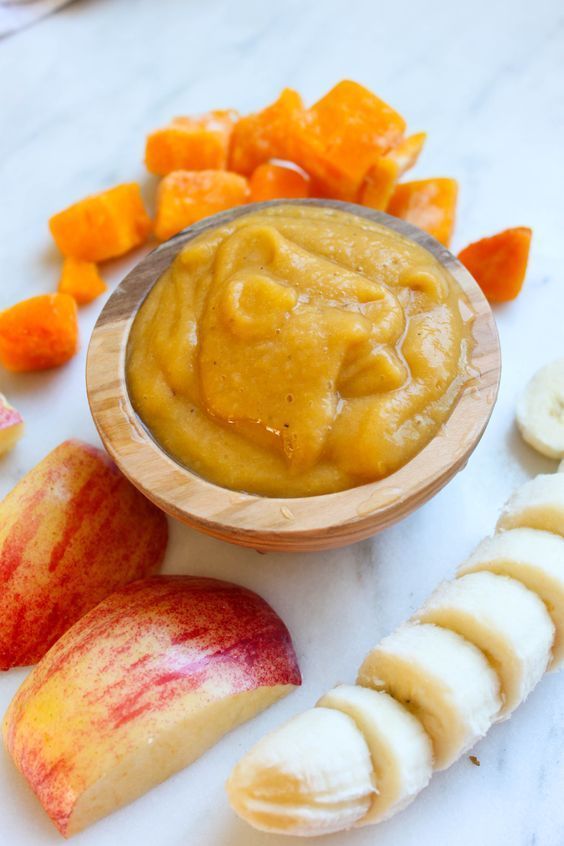
- Serve or freeze for another meal.
While I love the earthly, caramel flavor of roasted butternut squash, there are several ways you can cook butternut squash for baby food.
SteamingPeel and roughly chop 1 butternut squash. Place the cubes into a steamer basket over 2 inches of boiling water for 10-15 minutes or until tender when pricked with a fork. Puree in a blender as directed below.
BoilingPlace 1 peeled and roughly chopped butternut squash into a medium saucepan, add enough water to cover the butternut squash, and bring to a boil. Reduce to simmer and cook for 7-10 minutes or until tender when pricked with a fork. Puree in a blender as directed below. Note that boiling the butternut squash decreases the nutritional value of the puree since a lot of the nutrients are thrown out with the water after cooking.
Saving Time Tip: Steaming or boiling butternut squash are great methods to use if you are using prepared or frozen butternut squash.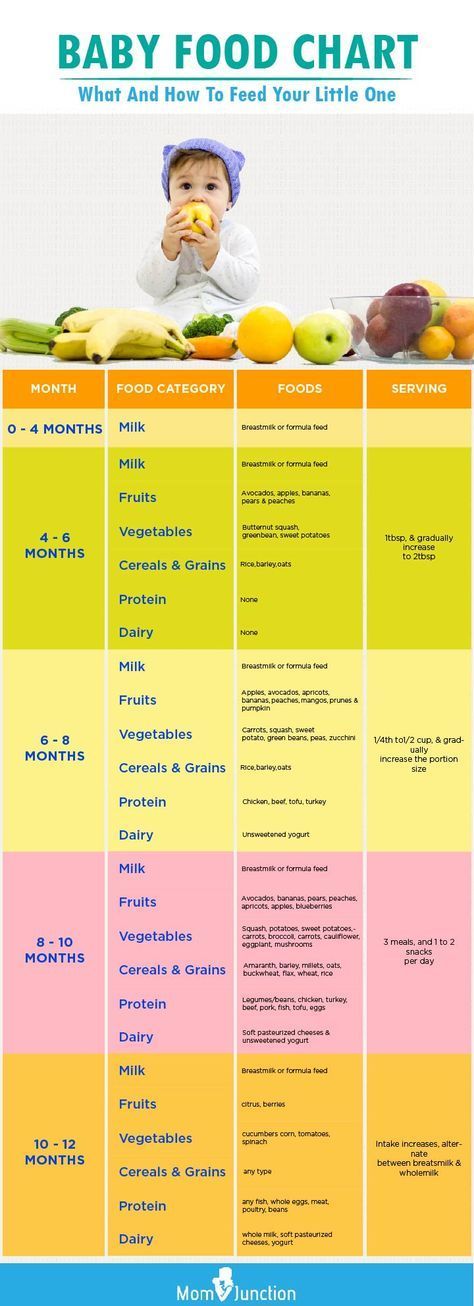 I have found both peeled and cubed fresh or frozen butternut squash in my grocery store, which are both viable options if you are short on time.
I have found both peeled and cubed fresh or frozen butternut squash in my grocery store, which are both viable options if you are short on time.
Frequently Asked Questions
Can butternut squash be baby’s first food
Butternut squash can 100% be your baby’s first food if you want it to be. It is recommended to wait to introduce the top eight allergen foods to your baby once a few other well-tolerated foods have been introduced, but otherwise, foods can be introduced in any order so choose whatever you are most excited for your baby to have.
Is butternut squash a common allergen for baby?
No, butternut squash is not a common allergen, however, as with any food, start with a small portion and be aware of any signs that might be an allergic reaction after introducing it.
When can baby eat butternut squash?
Babies can have butternut squash as one of their first foods.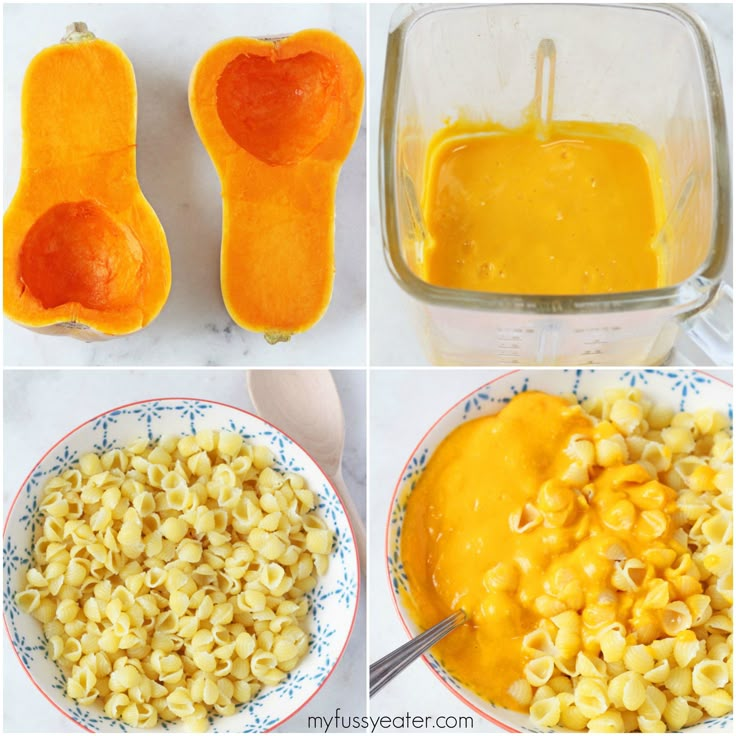 When a baby can start on solids is determined by their own rate of development, which generally comes between 4-6 months of age. Some of the developmental milestones babies need to reach in order to start solids include: if your baby has solid control of their head and neck, if your baby has doubled in weight, and if your baby is reaching for or opening their mouth when you eat (see my guide here). Before you start your baby on purees, you should consult with your pediatrician to make sure your child is developmentally ready.
When a baby can start on solids is determined by their own rate of development, which generally comes between 4-6 months of age. Some of the developmental milestones babies need to reach in order to start solids include: if your baby has solid control of their head and neck, if your baby has doubled in weight, and if your baby is reaching for or opening their mouth when you eat (see my guide here). Before you start your baby on purees, you should consult with your pediatrician to make sure your child is developmentally ready.
Can you add spices or herbs to this baby puree?
Yes! You can add in a pinch of chopped rosemary to this recipe, but feel free to use the following spices instead: basil, cilantro, ginger, nutmeg, coriander, mint, cinnamon, or mild curry powder (see quantity recommendations in the recipe card).
Tip on Spices: I always add spices or herbs to my baby food purees, but you can choose to leave them out in all of your baby food. You do you! Either way, this puree will surely taste amazing.
You do you! Either way, this puree will surely taste amazing.
Does butternut squash cause constipation for babies?
Butternut squash, though unlikely, may cause constipation in some babies, so avoid giving too much.
How to Store Butternut Squash Baby FoodRefrigeratorYou can store this puree in an airtight container in the fridge for up to 4 days.
FreezerThis puree can be frozen for up to 4 months.
- Spoon puree into a freezer storage container– do not overfill.
- Place the lid on the storage container or cover with a piece of saran wrap, and label with the date and recipe name.
- Place the tray into the freezer and let it freeze completely — preferably overnight.
- Pop-out the baby food cubes and place them in a ziplock baggie or stasher bag. Don’t forget to relabel the baggie or stager bag for future reference.
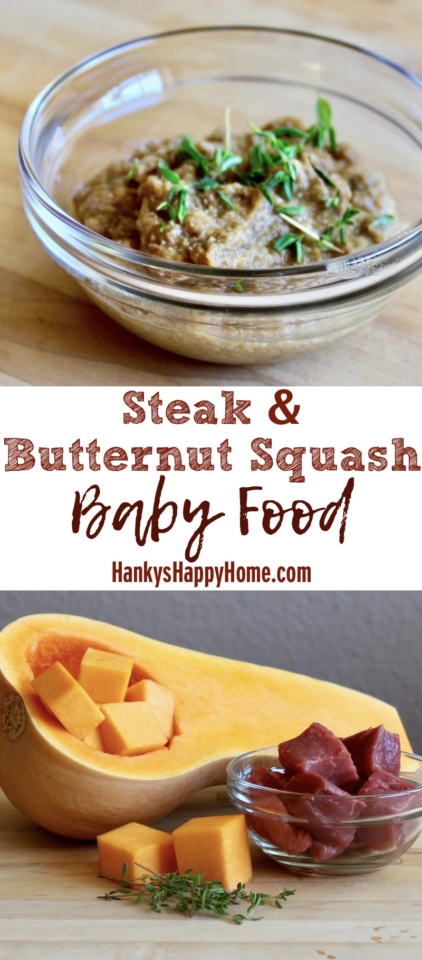
Need more information on how to store your baby foods? Head over to my Best Baby Food Storage Containers – Plus 6 Tips on Freezing and Thawing post!
Label Tip: Don’t forget to label your purees before you place them in the fridge or freezer with the name of the puree and the date you made it. Take it from me; by the end of the week, you will completely forget what is in your freezer and how long it’s been there. 😉
Puree Feeding Tips
- Follow your baby’s lead – when feeding purees from a spoon, sometimes there’s a tendency to keep offering bites past the point of your baby being full. Always follow baby’s cues for when they are done eating. Turning away from the spoon, closing her mouth, or pushing food away are all signs that baby is finished with the meal.
- Trial adding a little seasoning or spice to purees – babies like flavor! Or consider changing the temperature of purees from time to time, to slightly warmed or slightly chilled.
 Varying these aspects adds to the sensory experience!
Varying these aspects adds to the sensory experience! - Place a small amount of puree on the tray during spoon feeding, so that your baby can dip their fingers or hands in the puree. Allowing baby to explore foods in this way helps them learn to self-feed and can help them be more willing to try new textures and foods in the future.
While this butternut squash puree is tasty by itself, it’s also super easy to mix and match with other nutrient-dense baby food purees. So give these fun flavor combos a try!
- Apples
- Carrots
- Pears
- Cherries
- Quinoa Baby Cereal
- Chicken
- Corn
- Sweet Potato
- Soft Tofu
- Pumpkin
- Mango
- Cauliflower
- Yogurt
I’D LOVE TO KNOW HOW IT TURNED OUT! LEAVE A COMMENT AND A ⭐️ RATING BELOW 👇
Or watch a shortened version of the video here.
- 1 butternut squash
- 1 tsp fresh thyme or rosemary, roughly chopped
- 1-2 tsp olive oil (optional)
- 1/2-1 cup liquid (water, fresh breast milk, formula, stock or bone broth)
Preheat: Heat oven to 450 degrees F. Line baking sheet with a silicone mat, tin foil or parchment paper.
Prep: Cut butternut squash in half, deseed and place flesh side up, skin side down on the baking sheet. Optional – feel free to drizzle the squash with 2 teaspoons of olive oil for some added healthy fat.
Roast: Place the baking sheet into the oven and bake for 45-60 minutes or until you can easily prick the squash with a fork.

Peel: Let cool until you can handle the squash with your hands. Scrape the flesh off of the skin and place in a blender or food processor.
Add Herbs: Add the thyme or rosemary to the blender.
Puree: Turn on the blender or food processor and puree, adding liquid in 1/4 cup increments until you have the desired consistency. I had to add in 3/4 cup of water to my puree shown below.
Eat: Serve or freeze for later.
Age: 4-6 months and up
Yield: 25 ounces
Additional Spices: Feel free to sub the thyme or rosemary for 4 chopped basil leaves, 1 tsp chopped cilantro, 1/2 tsp minced fresh ginger, 1/2 teaspoon nutmeg, 1/2 tsp coriander, 1/2 tsp cinnamon or even 1/2 tsp of mind curry powder.
Freezer Tray
Blender
Silicone Baby Bibs
Bumkins Baby Bowl
Tripp Trapp High Chair
GreenPan Cookware
Did you make this recipe?
Tag @babyfoode on Instagram and hashtag it #babyfoode!
Pin Recipe Email a Friend
Zucchini puree for the first feeding
The introduction of zucchini in the first feeding is recommended by WHO, and zucchini puree for feeding the baby can be prepared without any problems yourself. There is nothing complicated in growing zucchini and the mature fruits of many varieties can be stored throughout the entire frosty period. The pulp of the fruit with elementary heat treatment retains its beneficial properties and is easily absorbed by the child's body even from an early age.
Contents
- How to cook courgettes for the first feeding
- Courgettes for complementary foods in baby food
- Composition of marrow
- Benefits of zucchini for children and adults
How to prepare zucchini for first feeding
If you decide to start feeding your baby, start with zucchini. It will be the best addition to breast milk or adapted formula. Zucchini is a hypoallergenic product and contains a large amount of nutrients needed by the child.
It will be the best addition to breast milk or adapted formula. Zucchini is a hypoallergenic product and contains a large amount of nutrients needed by the child.
Zucchini puree recipe
Cooking zucchini puree for the first feeding at home. Of the ingredients you need only zucchini and water. Let's start by rinsing the zucchini under cool running water. Peel off the skin and cut into cubes. Next 2 options. Either put it in boiling water, cook the zucchini for 6-10 minutes, while retaining the benefits of vitamin C. Or steam it, which will undoubtedly be tastier and healthier. Then we wipe through a sieve or grind with a blender.
You need to start complementary foods with one teaspoon, gradually day after day, increasing the number of spoons. It is important to introduce your child to this product at a very young age. When the child grows up, he will also need nutrients. And you can spoil him with many different zucchini dishes.
How to cook zucchini correctly and how much
For the first feeding, it is recommended to boil zucchini for up to 10 minutes. Usually this time is enough to soften the cut pieces. Do not forget that the longer the heat treatment of the vegetable takes place, the less vitamins and useful trace elements remain. Then everything is thoroughly crushed into puree and the first complementary foods are ready. Depending on the period of introduction of the puree to the baby, you can add a little vegetable oil to the puree if the mass of the portion of the puree has reached 100 g (usually on the 6th-7th day of feeding).
For the preparation of mashed potatoes, babies need to select only young and fresh zucchini fruits: without rot, cracks and dents. The fruit is thoroughly washed under running water. Then its lateral parts are cut off: the tail and the “butt”; peel is removed. The zucchini is cut lengthwise into several parts, from which the central soft part with seeds is removed. The remaining parts are cut into cubes. If the vegetable is bought at the market or in a store, it is recommended to soak the zucchini in clean water for about 2 hours to remove unnatural trace elements from the fruit in the form of fertilizers and pesticides.
How to freeze and defrost zucchini? Cooked cut fruit cubes in the right amount are placed in plastic bags or containers, and then in the refrigerator. For the preparation of frozen fruit puree, it is recommended to use a defrosted vegetable. To speed up the process, bags or containers with zucchini are placed in water at room temperature or under running tap water. After 1-2 hours, you can start cooking according to a known scheme.
Squash for complementary foods in baby food
Squash is widely used in baby food for its unique properties. In addition, vegetable squash purees are considered the most popular when introducing the first complementary foods to a child. One-component zucchini puree manufacturers recommend using for children from 4 months.
Table of the introduction of the first complementary foods with zucchini according to WHO recommendations
Baby food recommended for the first complementary foods includes Heinz zucchini puree, which additionally includes corn flour and water.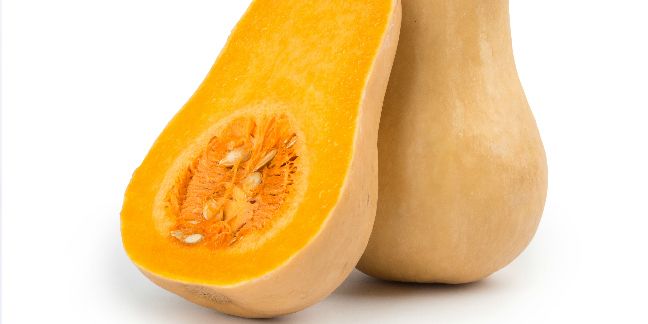 A similar product is Hipp zucchini puree, which contains coarse rice flour. These products are sold in glass jars with a net weight of 80 grams, and the puree contains no salt, sugar, starch, preservatives or dyes.
A similar product is Hipp zucchini puree, which contains coarse rice flour. These products are sold in glass jars with a net weight of 80 grams, and the puree contains no salt, sugar, starch, preservatives or dyes.
At a later age, in baby food, zucchini is used with vegetables, fruits, cereals and meat. For children over 5 months:
- Frutonyanya Broccoli and Zucchini Puree
- Puree Frutonyan zucchini and potatoes
- Frutonyanya puree cauliflower and marrow
- Puree Frutonyanya apples and zucchini
- Frutonyanya zucchini-oatmeal puree
- Gerber potato and courgette puree
- Puree Gerber apples and zucchini
Children's puree Tyoma beef with zucchini is recommended to try not earlier than 6 months from birth.
Ingredients of zucchini
Zucchini is a source of substances that have a beneficial effect on digestion. They contain a small amount of calories when cooked (20 to 25 kcal per 100 grams), so you can use them in food during therapeutic diets.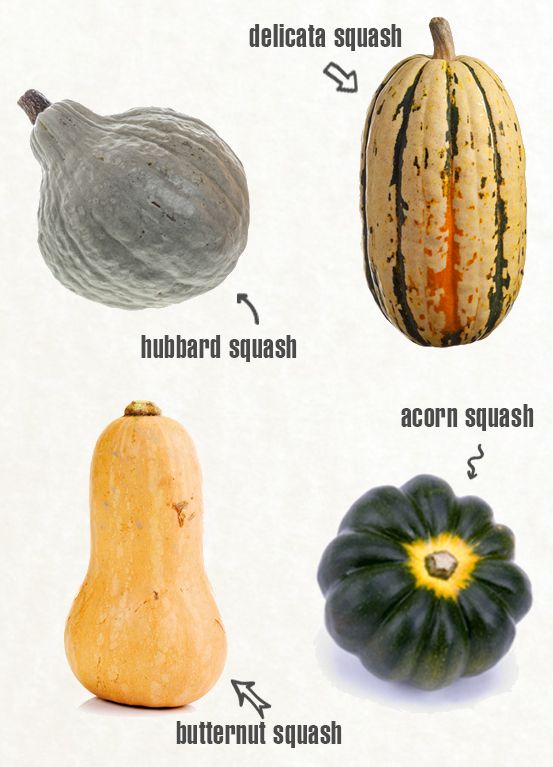
Fruits contain not only carbohydrates, fats and proteins, but also useful trace elements: sodium, iron, magnesium, zinc, iodine. In addition, the composition contains vitamins of groups B, C, E, H, PP, A.
Benefits of zucchini for children and adults
Zucchini has a very pleasant taste. Doctors advise them to use those who have undergone surgery on the stomach or intestines. I would like to mention that these fruits are very useful for those who suffer from edema.
Zucchini juice for men and women can help with obesity. Helps the body to get rid of toxins and slags, relieves constipation well, strengthens the heart. The glycogen in them has a positive effect on the activity of the liver. Zucchini significantly improves blood formation, helps to restore strength after prolonged exertion. Zucchini seeds will help get rid of worms. With hepatitis, regular consumption of zucchini will lead to a significant improvement in well-being.
Thus, the use of zucchini in the first feeding is the best option for both the child and the parents (of course, excluding the case of his individual intolerance).
Squash puree for the first feeding recipe
There are not so many products in the menu of babies up to a year that do not cause allergies. Such a dish is squash puree for the first feeding , the recipe of which is simple and allows you to combine it with other vegetables.
Benefits
Babies should first be given squash puree at 4 months of age. The vegetable product is easily digestible and is not an allergen. Zucchini is a healthy vegetable because it contains a number of nutrients necessary for the growth and development of the child. This vegetable product helps to eliminate any allergic reactions caused by other vegetables or fruits. Potassium and sodium contained in zucchini have a positive effect on the immune and nervous system of the crumbs.
The main benefit of the vegetable is the presence of vitamin C in it, which helps protect the baby from colds. Zucchini puree is an excellent remedy for constipation, its intake normalizes digestion, eliminates colic. Zucchini is a light food that does not overload the stomach. The benefits of pectins are excellent absorption and removal of excess fluid from the body.
Zucchini is a light food that does not overload the stomach. The benefits of pectins are excellent absorption and removal of excess fluid from the body.
Despite the variety of zucchini varieties, a white-fruited variety is better for the first baby. And since the children's diet excludes the use of salt and sugar, these components should not be added to zucchini puree - it itself has a pleasant sweetish taste.
Recommended servings
The first complementary foods for babies are best done in the form of serving vegetable puree. If the mother gave fruit mixtures as the main dish, which have a richer and sweeter taste, then the child may not accept vegetable puree.
First squash food should not exceed ½ tsp. It is better to give zucchini puree in the morning to monitor the baby's health after introducing a new vegetable into the diet.
Increase the amount of squash complementary foods if the child has tolerated zucchini well. The portion should eventually be 100 g. Gradually, you can combine zucchini with other vegetables, but the introduction of such dishes into the children's diet requires maintaining an interval of 5-7 days.
Gradually, you can combine zucchini with other vegetables, but the introduction of such dishes into the children's diet requires maintaining an interval of 5-7 days.
Preparation of puree for the winter
In the autumn-winter season, ready-made squash puree can be bought in the store, but often such products can contain bacteria as a result of long storage and transportation. In order for the child to receive healthy food, for the winter it is recommended to independently prepare a valuable vegetable - zucchini. It should be washed, cleaned, seeds removed from the inside. Cut the vegetable into medium cubes, put in a bag and freeze.
To prevent the cubes from being compressed into one lump, the best option is to make a blank in bags with the calculation for one serving. Quickly frozen homemade vegetable cubes will not lose their beneficial properties. When you need to make mashed potatoes for the first time, they are taken from the freezer and steamed.
How to make zucchini puree?
You can cook zucchini in different ways: for this, a double boiler, multicooker is used.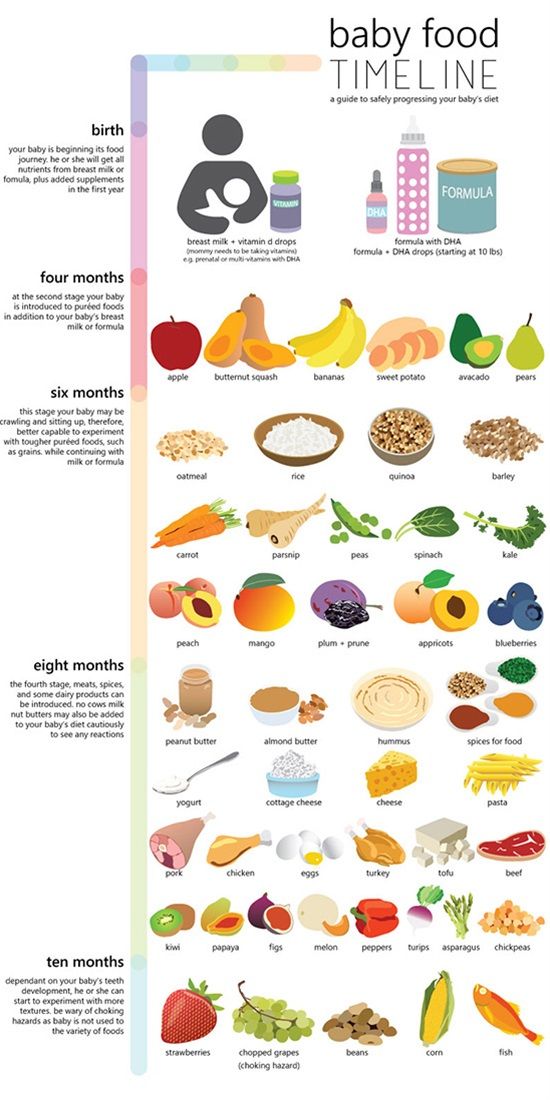 How to make zucchini puree for babies? Dishes should not contain spices, fat.
How to make zucchini puree for babies? Dishes should not contain spices, fat.
A serving of ⅓ or ¼ of a vegetable is suitable for a baby. To make food easily digested, young children are served on the first course of zucchini, chopped with a blender. After the baby's teeth erupt (this happens for about 8-11 months), it will be enough to knead the boiled healthy zucchini with a fork.
Baby food preparation process
Zucchini must be thoroughly washed, peeled, seeds removed. Cut into small cubes and boil in boiling water. When ready, remove from the pan, bring to a mushy state. To make zucchini puree liquid, it is diluted with breast milk. Lure of zucchini should be medium portions, you can cook the dish in boiling water. The liquid should just barely cover the vegetable cubes.
Zucchini is good not only as a first food, where it is served in chopped form without extraneous vegetables. It can also be used to make another equally delicious homemade dish.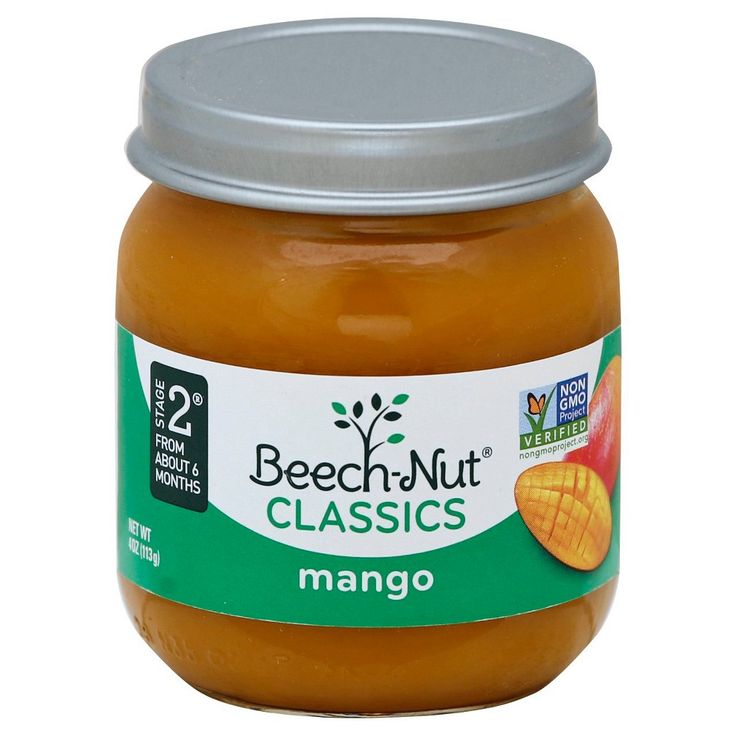 A baby can use cream soup, vegetable stew, caviar, pancakes, ketchup for porridge.
A baby can use cream soup, vegetable stew, caviar, pancakes, ketchup for porridge.
Cooking zucchini for a child for a couple
Before cooking zucchini in a slow cooker, it is pre-soaked for 2 hours in cold water with the addition of salt. For the first feeding for babies, it is recommended to choose young varieties of small size. Shop zucchini are selected primarily for their appearance. They must be free of obvious defects. A slow cooker or a double boiler will help to save most of the beneficial vitamins in zucchini.
To cook a vegetable in a double boiler, it will need to be peeled and the seeds removed. Cut into cubes, cook no more than 10 minutes. If kitchen appliances are not available, a zucchini dish can be cooked in a standard way, in a saucepan. To do this, the container is filled with water by ¼ part. The vegetable is washed, cut and thrown back on a sieve. To cook quickly, the pan must be covered with a lid.
In a slow cooker, zucchini can be cooked in this way: wash the vegetable, remove the seeds, cut into cubes, steam.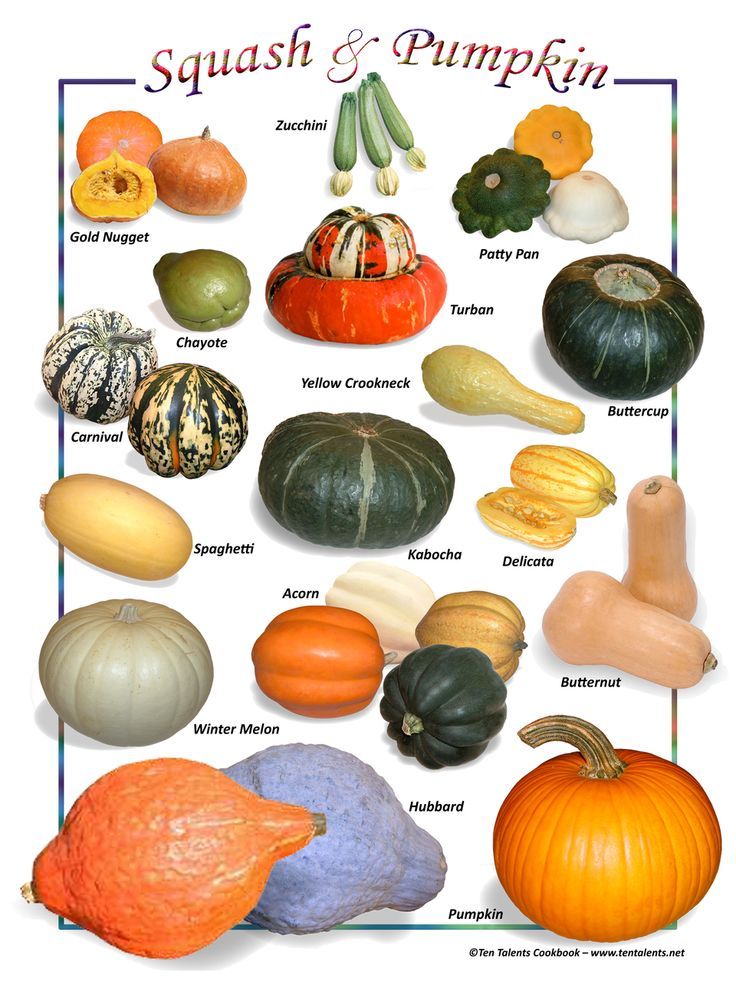 For cooking, use the “cooking” or “stewing” mode, cook mashed potatoes for 20 minutes. When serving, zucchini is brought to a state of puree.
For cooking, use the “cooking” or “stewing” mode, cook mashed potatoes for 20 minutes. When serving, zucchini is brought to a state of puree.
It is very important to follow the rules for preparing baby food:
- Squash complementary foods should be diluted with breast milk during preparation. Store-bought can be diluted when the child reaches the age of 1.5 years.
- The vegetable is compatible with other root crops, but for the first feeding it is better to give it in its pure form.
- Squash complementary foods do not cause an allergic reaction, which cannot be said about its seeds. Only the pulp is suitable for mashing.
- Squash for babies is simmered over low heat for no more than 10 minutes. After it becomes soft, the broth is drained and placed in a blender.
- A few weeks after the first use of the squash dish, olive or unrefined sunflower oil can be added to the classic recipe in a proportion of 1 tsp. in a day.
- An infant who is 7 months old can drink squash juice half an hour before the main complementary foods.


